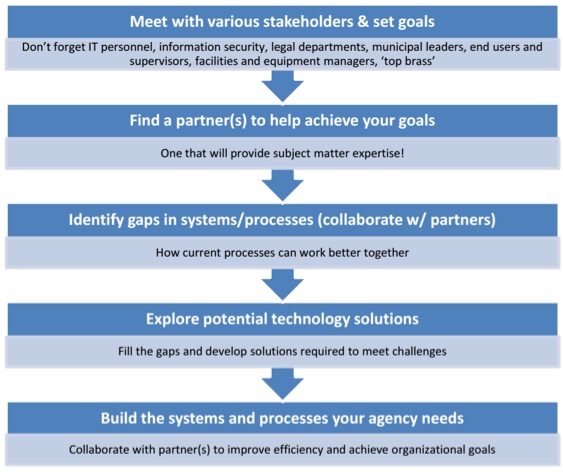Balancing Act: Law Enforcement Systems Improvements Using Barcodes & Technology

From the devices on our desks and at our offices, to the technology in our vehicles and our pockets, computers and digital systems are used to make us more effective on just about every level.
In this “Digital Age,” a goal of efficiency doesn’t stop in our personal lives or the business environment, but also plays a sizable role in government, public service, and law enforcement problem-solving as well.
One problem the Buffalo Valley Regional Police Department (BVRPD) sought to mitigate involved traffic-related incidents. Traffic-related incidents have been the leading cause of law enforcement line-of-duty deaths (LODDs) for many years. Though many measures have been put in place to mitigate this dramatic threat to officers’ life and safety, BVRPD wanted to do more to promote scene safety while performing traffic stops – and they wanted to use barcode scanning technology to do it.
According to 2011 International Association of Chiefs of Police (IACP) Division of State and Provincial Police (S&P) research entitled, “Preventing Traffic-Related Line-of-Duty Deaths,” law enforcement officers are four times more likely to be involved in a traffic collision than the average civilian motorist (1). In fact, 150 law enforcement officers were killed between 2000-2009 as a direct result of traffic-related incidents (60% of all officer deaths in that time period).
Forty-two percent of those fatal traffic incidents involved officers being struck on the side of the road. With officer safety perpetually on the minds of law enforcement leadership, what can be done to promote officer safety?
Of the strides made within the past few years, road-side safety programs have driven improvements to increase the conspicuity of vehicles and officers (reflective markings and clothing, more emergency lighting, improved on-scene vehicle positioning, etc.), encourage passing motorists to move over and/or slow down, and train law enforcement personnel in safer methods for approaching traffic stops and assessing scene safety.
These measures, while important, did not solve the larger issue; traffic stops are still, inherently, one of the most dangerous tasks any law enforcement officer performs on a day-to-day basis. Though we cannot effectively eliminate the danger, one additional approach an agency can take to promote officer safety while performing traffic stops is to use automated technology solutions that shorten the amount of time necessary to perform a traffic stop.
The idea is simple: if you reduce the amount of time necessary to complete a traffic stop, you reduce the level of vulnerability officers are subjected to on the side of the road. That’s where barcode scanning technology comes in.

Automation and the use of driver license database information to populate fields on a citation, for example, can save officers a significant amount of time when issuing citations (it takes about ¼ of the time to complete an e-citation when compared to paper); this advancement promotes increased officer safety and can also improve records management accuracy. By letting a computer and other automated technology solutions (area-imaging scanners, in-vehicle printers, etc.) do the work, the officer can focus on critical elements of scene safety and maintain a heightened level of awareness.
These technologies result in less time on the side of the road, directly impacting the number of LODDs experienced in law enforcement and providing a variety of other system improvements.
- - -
eCitation is a rare case of successful systems customization. What happens when a technology solution is not optimized for all users and what can we learn from this?
Computers and other technology are meant to help us do our jobs better, but sometimes these “efficient” systems create more work, frustration and hassle for the end-user. Other times, these technology systems or work processes are modified to benefit the end-user (e.g. the patrol officer filling out an electronic citation) but neglect the needs of other administrative personnel processing the reports, distributing them to necessary partners and stakeholders, etc.
Every time a skewed system is used that benefits one user over another, that system stresses overall productivity and damages our ability to serve our stakeholders.
A holistic approach to systems improvement and customization is necessary to achieve true efficiency. To do this, those leaders involved in the systems improvement process must take a broad view of many moving parts to create a cohesive, well-designed whole. They must be “design thinkers”.

The eCitation system was customized with all users in mind. The officer entering the data into the system benefits from automated barcode scanning technology, shortening the amount of time necessary to complete a citation; this automation, in turn, results in legible, typed citations for administrative personnel to process. This customized solution doesn’t stop at providing efficiency and automation within BVRPD’s office, though; after this information is automatically transmitted to their agency office and processed, it is also immediately sent to the court office for processing.
The result: a faster, improved citation management system with a variety of measurable benefits – dollars, time, frustration, accuracy, safety and a simpler “customer” experience.
How you can drive technology leadership more effectively:

When developing or customizing technology systems, remember to start broad and maintain a solid understanding of how each of your systems/processes affects various stakeholders. This approach can improve day-to-day operations, positively impact morale and job satisfaction, and establish your organization as a thought-leader in a variety of areas.
Use design thinking and collaborative partners to your advantage!
About the author:
RAD DeRose is the President & CEO of L-Tron Corporation. He has over 30 years of experience in industrial automation and data collection solutions and brings a deep industry knowledge-base on the challenges faced in the commercial and public safety sectors.
(1) Source: http://www.theiacp.org/Portals/0/pdfs/Traffic-RelatedLODReport.pdf
More great articles about municipalities and governments using bar codes and RFID (please read and share):
